Impact of Digital Technology on Small Business: A Project Report
VerifiedAdded on 2020/06/04
|26
|5817
|347
Report
AI Summary
This report examines the impact of digital technology on small business growth and innovation, focusing on the case study of ThirdWay Interior, a UK-based small-scale organization. The study begins by devising project aims and objectives, followed by the development of a comprehensive project management plan, incorporating aspects of cost, time, scope, communication, quality, resources, and risk. A detailed project schedule, milestone schedule, work breakdown structure, and Gantt chart are also included. The research methodology involves both quantitative and qualitative methods to gather and analyze data from employees and managers. The report evaluates the accuracy and reliability of the applied research methods, and provides a critical evaluation of the project management process. Data analysis techniques and tools are used to communicate recommendations for effective digital technology implementation. The report concludes with a reflection on the value of research in meeting objectives and offers recommendations for the organization's digital transformation.
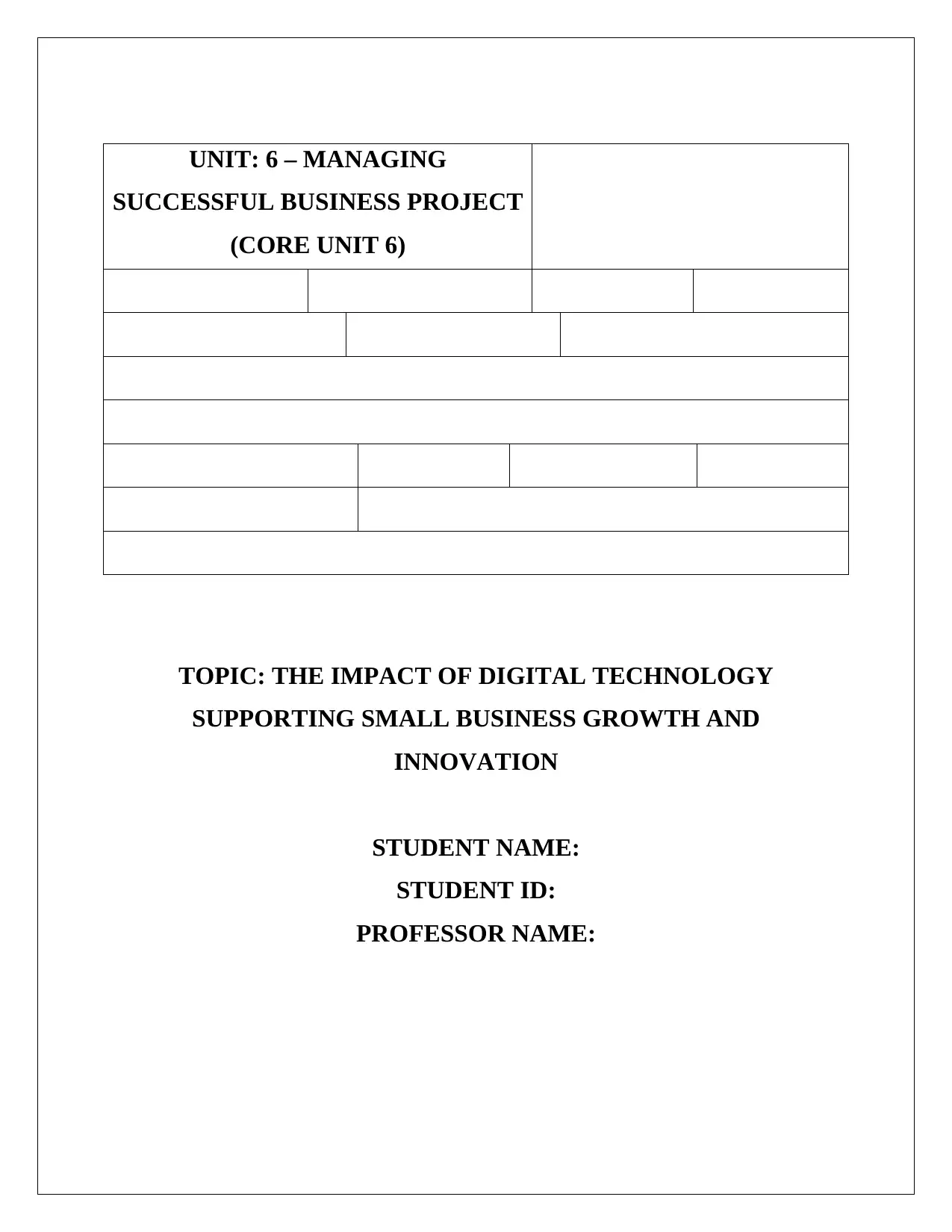
UNIT: 6 – MANAGING
SUCCESSFUL BUSINESS PROJECT
(CORE UNIT 6)
TOPIC: THE IMPACT OF DIGITAL TECHNOLOGY
SUPPORTING SMALL BUSINESS GROWTH AND
INNOVATION
STUDENT NAME:
STUDENT ID:
PROFESSOR NAME:
SUCCESSFUL BUSINESS PROJECT
(CORE UNIT 6)
TOPIC: THE IMPACT OF DIGITAL TECHNOLOGY
SUPPORTING SMALL BUSINESS GROWTH AND
INNOVATION
STUDENT NAME:
STUDENT ID:
PROFESSOR NAME:
Paraphrase This Document
Need a fresh take? Get an instant paraphrase of this document with our AI Paraphraser
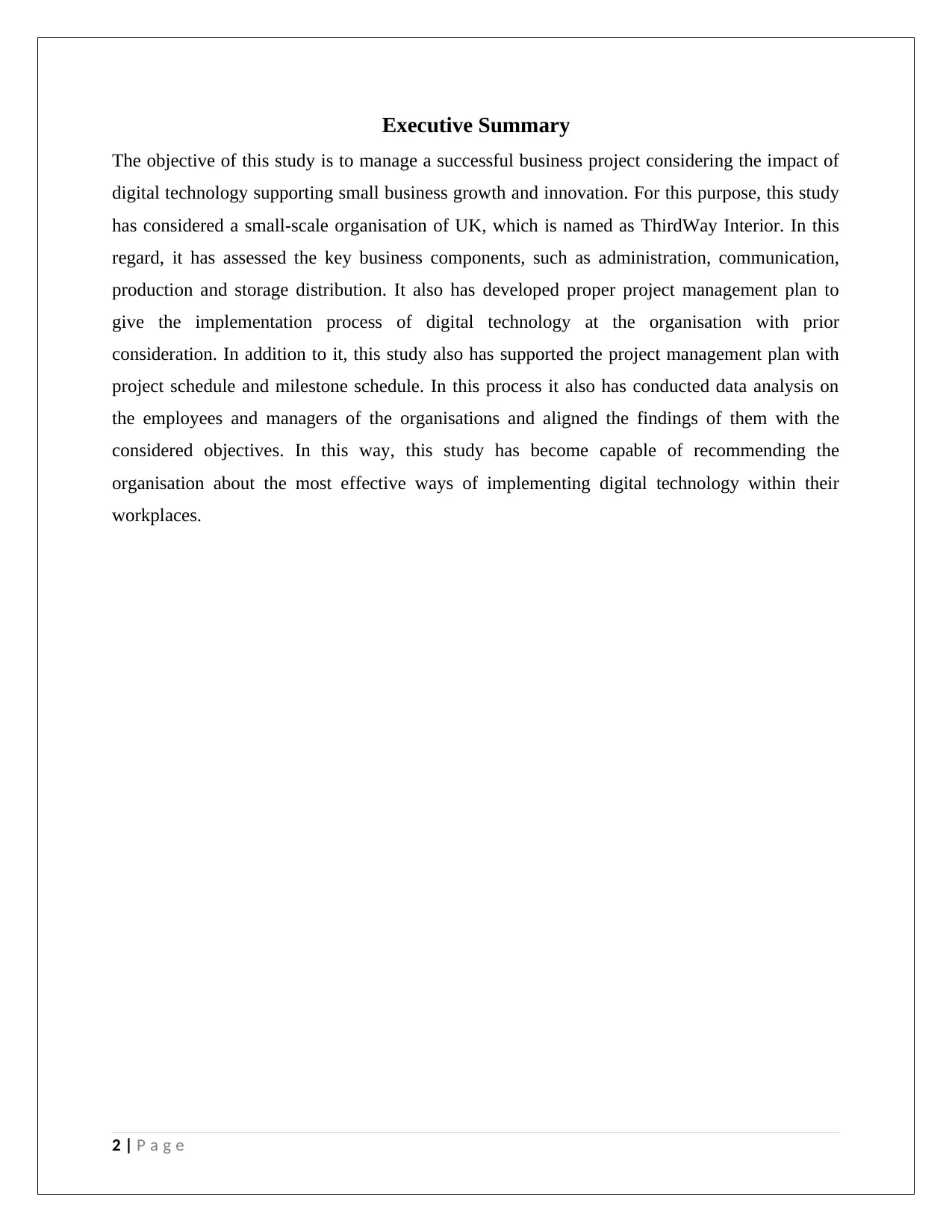
Executive Summary
The objective of this study is to manage a successful business project considering the impact of
digital technology supporting small business growth and innovation. For this purpose, this study
has considered a small-scale organisation of UK, which is named as ThirdWay Interior. In this
regard, it has assessed the key business components, such as administration, communication,
production and storage distribution. It also has developed proper project management plan to
give the implementation process of digital technology at the organisation with prior
consideration. In addition to it, this study also has supported the project management plan with
project schedule and milestone schedule. In this process it also has conducted data analysis on
the employees and managers of the organisations and aligned the findings of them with the
considered objectives. In this way, this study has become capable of recommending the
organisation about the most effective ways of implementing digital technology within their
workplaces.
2 | P a g e
The objective of this study is to manage a successful business project considering the impact of
digital technology supporting small business growth and innovation. For this purpose, this study
has considered a small-scale organisation of UK, which is named as ThirdWay Interior. In this
regard, it has assessed the key business components, such as administration, communication,
production and storage distribution. It also has developed proper project management plan to
give the implementation process of digital technology at the organisation with prior
consideration. In addition to it, this study also has supported the project management plan with
project schedule and milestone schedule. In this process it also has conducted data analysis on
the employees and managers of the organisations and aligned the findings of them with the
considered objectives. In this way, this study has become capable of recommending the
organisation about the most effective ways of implementing digital technology within their
workplaces.
2 | P a g e
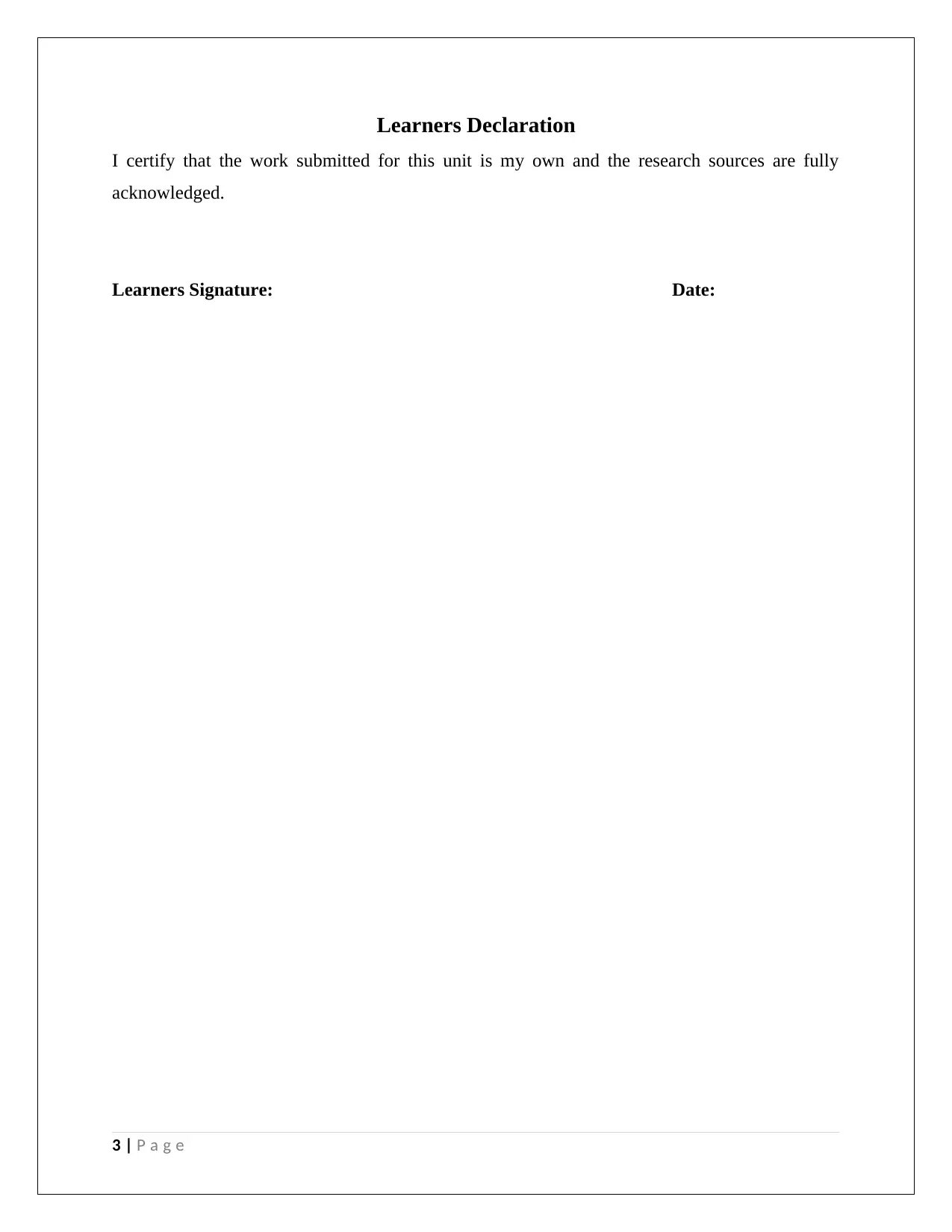
Learners Declaration
I certify that the work submitted for this unit is my own and the research sources are fully
acknowledged.
Learners Signature: Date:
3 | P a g e
I certify that the work submitted for this unit is my own and the research sources are fully
acknowledged.
Learners Signature: Date:
3 | P a g e
⊘ This is a preview!⊘
Do you want full access?
Subscribe today to unlock all pages.

Trusted by 1+ million students worldwide
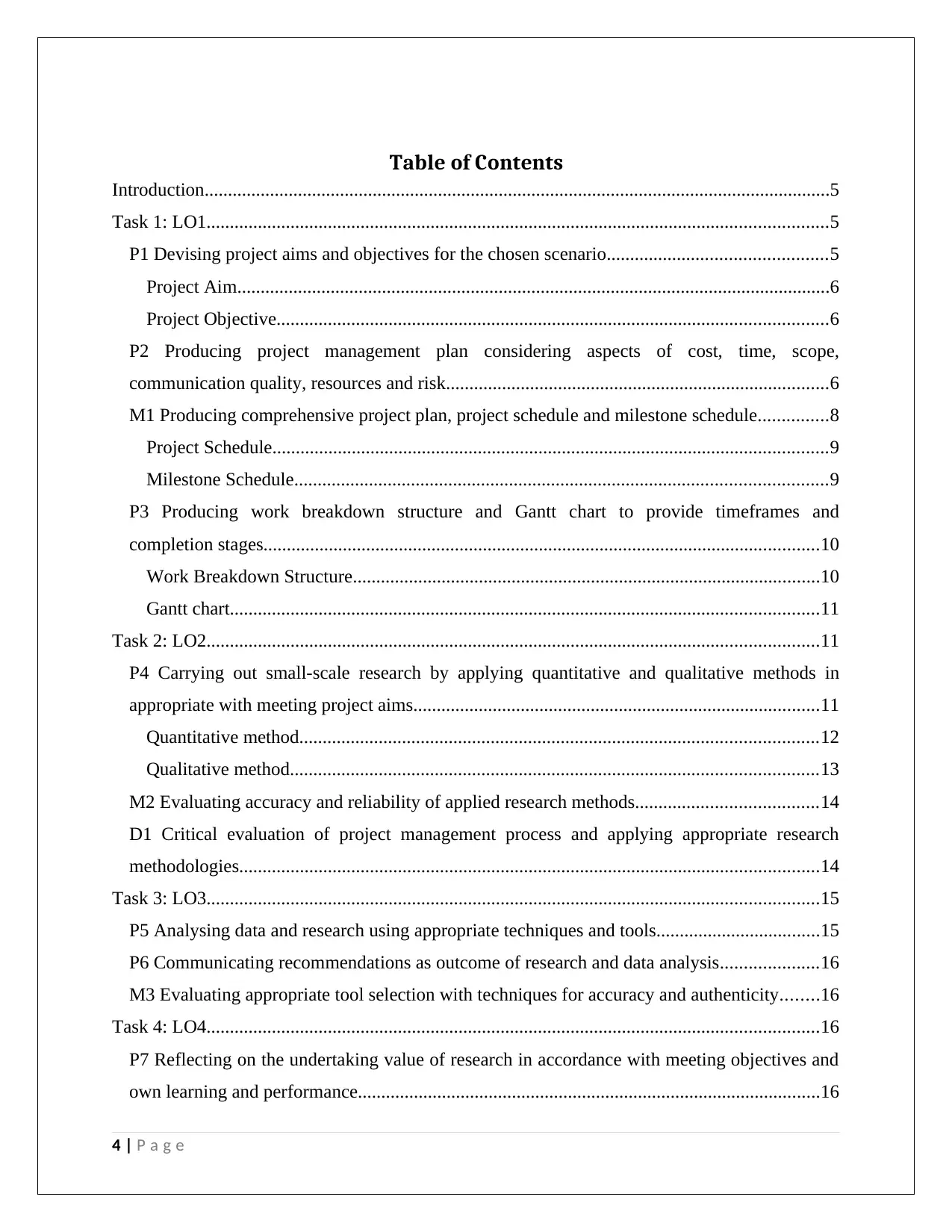
Table of Contents
Introduction......................................................................................................................................5
Task 1: LO1.....................................................................................................................................5
P1 Devising project aims and objectives for the chosen scenario...............................................5
Project Aim...............................................................................................................................6
Project Objective......................................................................................................................6
P2 Producing project management plan considering aspects of cost, time, scope,
communication quality, resources and risk..................................................................................6
M1 Producing comprehensive project plan, project schedule and milestone schedule...............8
Project Schedule.......................................................................................................................9
Milestone Schedule..................................................................................................................9
P3 Producing work breakdown structure and Gantt chart to provide timeframes and
completion stages.......................................................................................................................10
Work Breakdown Structure....................................................................................................10
Gantt chart..............................................................................................................................11
Task 2: LO2...................................................................................................................................11
P4 Carrying out small-scale research by applying quantitative and qualitative methods in
appropriate with meeting project aims.......................................................................................11
Quantitative method...............................................................................................................12
Qualitative method.................................................................................................................13
M2 Evaluating accuracy and reliability of applied research methods.......................................14
D1 Critical evaluation of project management process and applying appropriate research
methodologies............................................................................................................................14
Task 3: LO3...................................................................................................................................15
P5 Analysing data and research using appropriate techniques and tools...................................15
P6 Communicating recommendations as outcome of research and data analysis.....................16
M3 Evaluating appropriate tool selection with techniques for accuracy and authenticity........16
Task 4: LO4...................................................................................................................................16
P7 Reflecting on the undertaking value of research in accordance with meeting objectives and
own learning and performance...................................................................................................16
4 | P a g e
Introduction......................................................................................................................................5
Task 1: LO1.....................................................................................................................................5
P1 Devising project aims and objectives for the chosen scenario...............................................5
Project Aim...............................................................................................................................6
Project Objective......................................................................................................................6
P2 Producing project management plan considering aspects of cost, time, scope,
communication quality, resources and risk..................................................................................6
M1 Producing comprehensive project plan, project schedule and milestone schedule...............8
Project Schedule.......................................................................................................................9
Milestone Schedule..................................................................................................................9
P3 Producing work breakdown structure and Gantt chart to provide timeframes and
completion stages.......................................................................................................................10
Work Breakdown Structure....................................................................................................10
Gantt chart..............................................................................................................................11
Task 2: LO2...................................................................................................................................11
P4 Carrying out small-scale research by applying quantitative and qualitative methods in
appropriate with meeting project aims.......................................................................................11
Quantitative method...............................................................................................................12
Qualitative method.................................................................................................................13
M2 Evaluating accuracy and reliability of applied research methods.......................................14
D1 Critical evaluation of project management process and applying appropriate research
methodologies............................................................................................................................14
Task 3: LO3...................................................................................................................................15
P5 Analysing data and research using appropriate techniques and tools...................................15
P6 Communicating recommendations as outcome of research and data analysis.....................16
M3 Evaluating appropriate tool selection with techniques for accuracy and authenticity........16
Task 4: LO4...................................................................................................................................16
P7 Reflecting on the undertaking value of research in accordance with meeting objectives and
own learning and performance...................................................................................................16
4 | P a g e
Paraphrase This Document
Need a fresh take? Get an instant paraphrase of this document with our AI Paraphraser
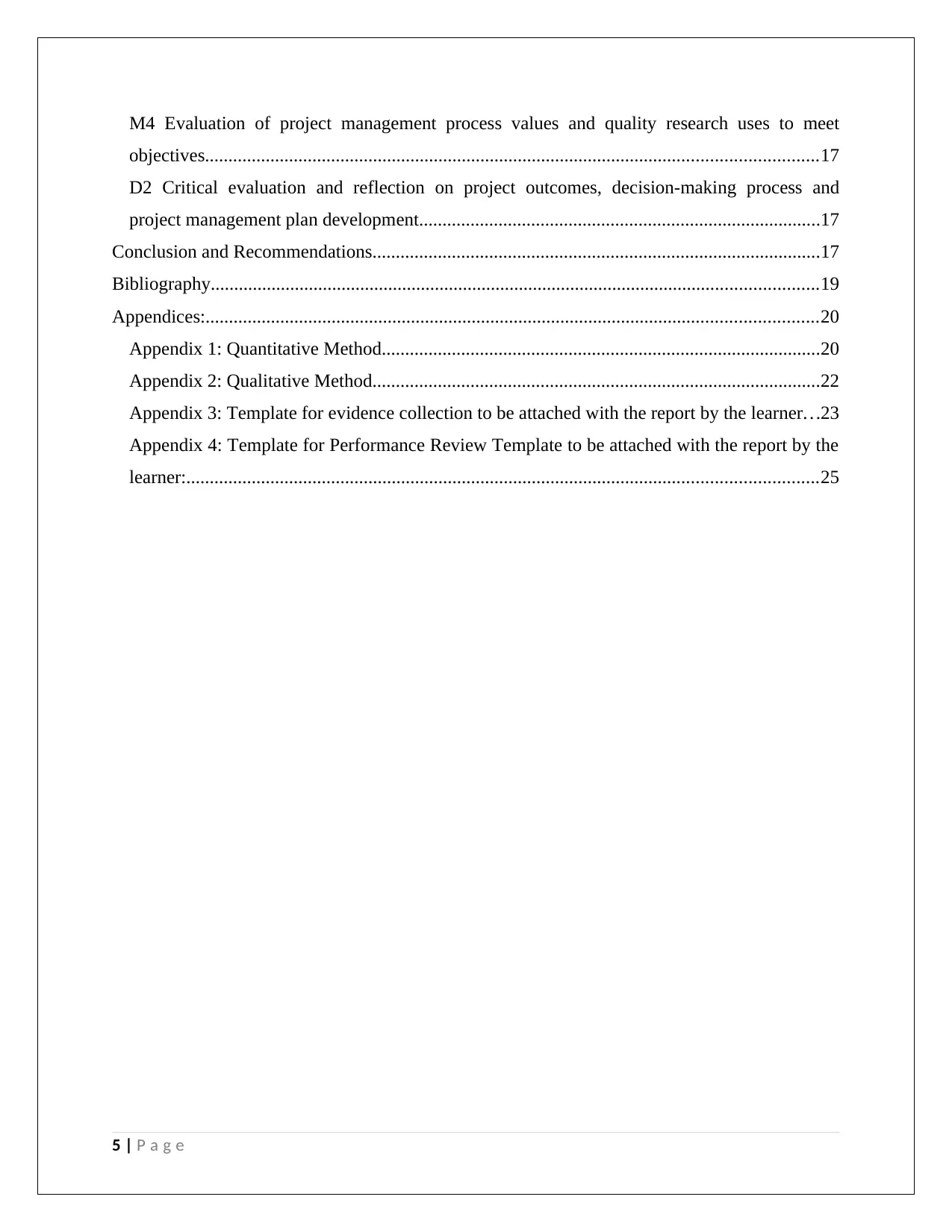
M4 Evaluation of project management process values and quality research uses to meet
objectives...................................................................................................................................17
D2 Critical evaluation and reflection on project outcomes, decision-making process and
project management plan development......................................................................................17
Conclusion and Recommendations................................................................................................17
Bibliography..................................................................................................................................19
Appendices:...................................................................................................................................20
Appendix 1: Quantitative Method..............................................................................................20
Appendix 2: Qualitative Method................................................................................................22
Appendix 3: Template for evidence collection to be attached with the report by the learner...23
Appendix 4: Template for Performance Review Template to be attached with the report by the
learner:.......................................................................................................................................25
5 | P a g e
objectives...................................................................................................................................17
D2 Critical evaluation and reflection on project outcomes, decision-making process and
project management plan development......................................................................................17
Conclusion and Recommendations................................................................................................17
Bibliography..................................................................................................................................19
Appendices:...................................................................................................................................20
Appendix 1: Quantitative Method..............................................................................................20
Appendix 2: Qualitative Method................................................................................................22
Appendix 3: Template for evidence collection to be attached with the report by the learner...23
Appendix 4: Template for Performance Review Template to be attached with the report by the
learner:.......................................................................................................................................25
5 | P a g e

Introduction
Digital technology within the organisations has been playing pivotal roles in the organisational
growth and innovation process. It also has improved the sustainability developments for the
small-scale industries as well. For this purpose, this study has tried to shed light on the
effectiveness and requirements of digital technology at the small-scale organisations by
developing a project management plan. In this regard, it has conserved a small-scale organisation
of UK, named as ThirdWay Interior. This company has been associated with the small and
medium sized industry of UK with an employee base of 59 and a turnover below $3 million per
annum.
Figure 1: Logo of ThirdWay Interior
(Source: thirdwayinteriors.com. 2017)
Task 1: LO1
P1 Devising project aims and objectives for the chosen scenario
The project management plan considering the issue regarding the impact of digital technology in
support of small business growth and innovation is liable to be involved with major
contemporary organisational issues. In the words of Spencer et al. (2012), the managements of
the organisations around the world have been found largely associated with this issue either
actively or passively. In most of the cases, the managements of the organisations are found to be
6 | P a g e
Digital technology within the organisations has been playing pivotal roles in the organisational
growth and innovation process. It also has improved the sustainability developments for the
small-scale industries as well. For this purpose, this study has tried to shed light on the
effectiveness and requirements of digital technology at the small-scale organisations by
developing a project management plan. In this regard, it has conserved a small-scale organisation
of UK, named as ThirdWay Interior. This company has been associated with the small and
medium sized industry of UK with an employee base of 59 and a turnover below $3 million per
annum.
Figure 1: Logo of ThirdWay Interior
(Source: thirdwayinteriors.com. 2017)
Task 1: LO1
P1 Devising project aims and objectives for the chosen scenario
The project management plan considering the issue regarding the impact of digital technology in
support of small business growth and innovation is liable to be involved with major
contemporary organisational issues. In the words of Spencer et al. (2012), the managements of
the organisations around the world have been found largely associated with this issue either
actively or passively. In most of the cases, the managements of the organisations are found to be
6 | P a g e
⊘ This is a preview!⊘
Do you want full access?
Subscribe today to unlock all pages.

Trusted by 1+ million students worldwide

categorising their strategies in regards to acknowledge the emerging impacts of digital
technologies. However, the adoption and interest of considering digital technology have been
found extensively tangible among the entrepreneurs and small-scale managements in comparison
to the large scale enterprises.
Project Aim
The aim of the project is to demonstrate the impacts of digital technology that support business
growth and innovation within the organisation. For this purpose, this study has shed light on the
dependent and independent variables associated with the uses of digital technologies within the
organisations. In line with this it also has focused on the avenues that the managements of the
organisations utilise them for the purpose of enhancing their business growth and innovation
within the competitive markets. Shedding light on the emerging uses of digital technologies and
their advanced implementations within the organisations has also been considered in this study
as prior project aims.
Project Objective
To address the variables of digital technology usages within the organisations
To find out the processes of implementations of digital technology
To assess the impacts of digital technology in organisational innovation and growth
To evaluate success of small businesses through the implementation of digital technology
To recommend the most effective ways of utilising digital technology within organisation
P2 Producing project management plan considering aspects of cost, time, scope,
communication quality, resources and risk
Project management plan refers to the process how the strategies are developed for the purpose
of devising a project. Project management plan also helps the organisations to develop an
overview on the project considerations along with intense discussions on them. According to
Fitzgerald et al. (2014), the project management plans are developed on the basis of the prior
consideration of a certain issue or an aspect that is supposed to be implemented for the purpose
of organisational development within the competitive markets. In this context, the management
of an organisation is required to sort out the aspects of project managements on the prior basis of
their implementation measures. This study has tried to develop a project management plan for
7 | P a g e
technologies. However, the adoption and interest of considering digital technology have been
found extensively tangible among the entrepreneurs and small-scale managements in comparison
to the large scale enterprises.
Project Aim
The aim of the project is to demonstrate the impacts of digital technology that support business
growth and innovation within the organisation. For this purpose, this study has shed light on the
dependent and independent variables associated with the uses of digital technologies within the
organisations. In line with this it also has focused on the avenues that the managements of the
organisations utilise them for the purpose of enhancing their business growth and innovation
within the competitive markets. Shedding light on the emerging uses of digital technologies and
their advanced implementations within the organisations has also been considered in this study
as prior project aims.
Project Objective
To address the variables of digital technology usages within the organisations
To find out the processes of implementations of digital technology
To assess the impacts of digital technology in organisational innovation and growth
To evaluate success of small businesses through the implementation of digital technology
To recommend the most effective ways of utilising digital technology within organisation
P2 Producing project management plan considering aspects of cost, time, scope,
communication quality, resources and risk
Project management plan refers to the process how the strategies are developed for the purpose
of devising a project. Project management plan also helps the organisations to develop an
overview on the project considerations along with intense discussions on them. According to
Fitzgerald et al. (2014), the project management plans are developed on the basis of the prior
consideration of a certain issue or an aspect that is supposed to be implemented for the purpose
of organisational development within the competitive markets. In this context, the management
of an organisation is required to sort out the aspects of project managements on the prior basis of
their implementation measures. This study has tried to develop a project management plan for
7 | P a g e
Paraphrase This Document
Need a fresh take? Get an instant paraphrase of this document with our AI Paraphraser
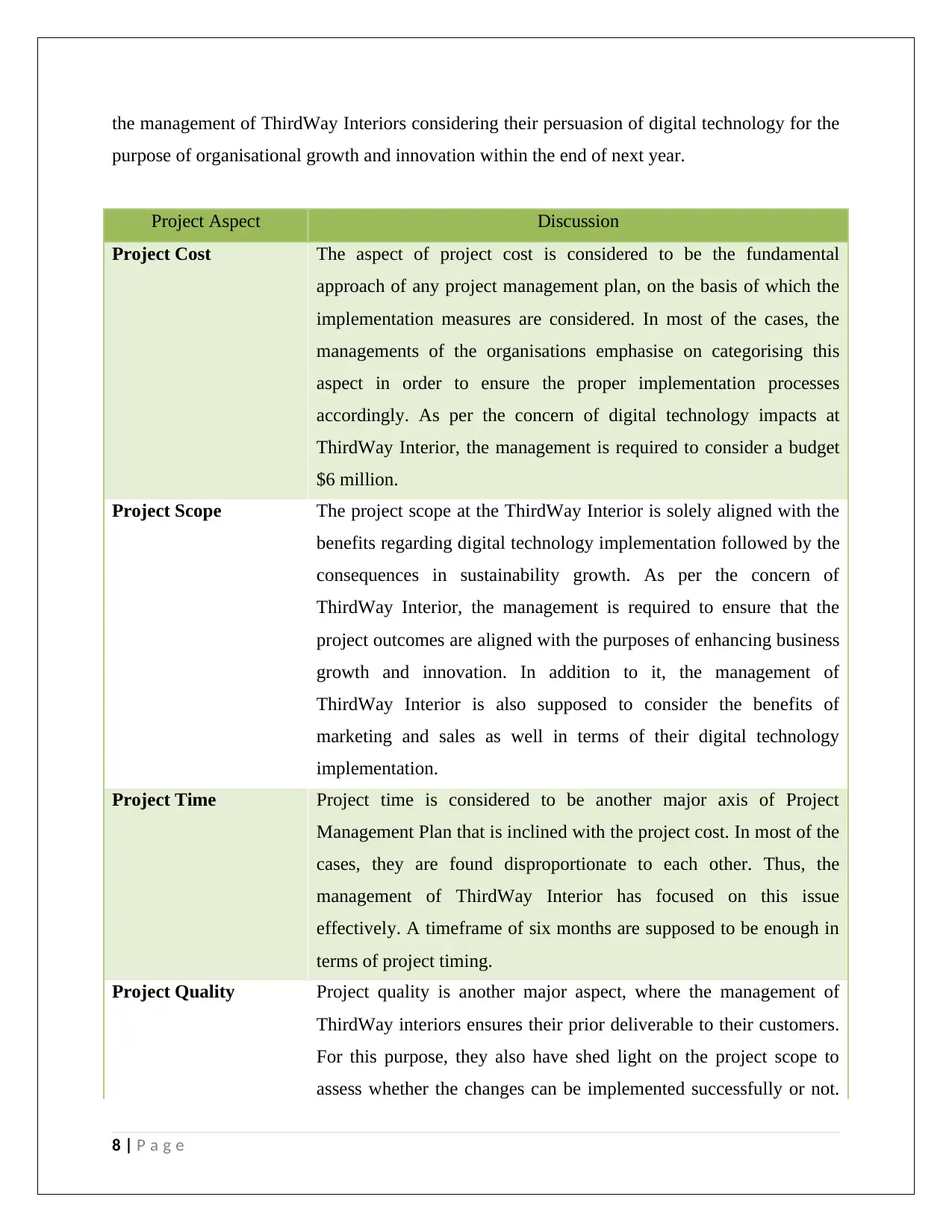
the management of ThirdWay Interiors considering their persuasion of digital technology for the
purpose of organisational growth and innovation within the end of next year.
Project Aspect Discussion
Project Cost The aspect of project cost is considered to be the fundamental
approach of any project management plan, on the basis of which the
implementation measures are considered. In most of the cases, the
managements of the organisations emphasise on categorising this
aspect in order to ensure the proper implementation processes
accordingly. As per the concern of digital technology impacts at
ThirdWay Interior, the management is required to consider a budget
$6 million.
Project Scope The project scope at the ThirdWay Interior is solely aligned with the
benefits regarding digital technology implementation followed by the
consequences in sustainability growth. As per the concern of
ThirdWay Interior, the management is required to ensure that the
project outcomes are aligned with the purposes of enhancing business
growth and innovation. In addition to it, the management of
ThirdWay Interior is also supposed to consider the benefits of
marketing and sales as well in terms of their digital technology
implementation.
Project Time Project time is considered to be another major axis of Project
Management Plan that is inclined with the project cost. In most of the
cases, they are found disproportionate to each other. Thus, the
management of ThirdWay Interior has focused on this issue
effectively. A timeframe of six months are supposed to be enough in
terms of project timing.
Project Quality Project quality is another major aspect, where the management of
ThirdWay interiors ensures their prior deliverable to their customers.
For this purpose, they also have shed light on the project scope to
assess whether the changes can be implemented successfully or not.
8 | P a g e
purpose of organisational growth and innovation within the end of next year.
Project Aspect Discussion
Project Cost The aspect of project cost is considered to be the fundamental
approach of any project management plan, on the basis of which the
implementation measures are considered. In most of the cases, the
managements of the organisations emphasise on categorising this
aspect in order to ensure the proper implementation processes
accordingly. As per the concern of digital technology impacts at
ThirdWay Interior, the management is required to consider a budget
$6 million.
Project Scope The project scope at the ThirdWay Interior is solely aligned with the
benefits regarding digital technology implementation followed by the
consequences in sustainability growth. As per the concern of
ThirdWay Interior, the management is required to ensure that the
project outcomes are aligned with the purposes of enhancing business
growth and innovation. In addition to it, the management of
ThirdWay Interior is also supposed to consider the benefits of
marketing and sales as well in terms of their digital technology
implementation.
Project Time Project time is considered to be another major axis of Project
Management Plan that is inclined with the project cost. In most of the
cases, they are found disproportionate to each other. Thus, the
management of ThirdWay Interior has focused on this issue
effectively. A timeframe of six months are supposed to be enough in
terms of project timing.
Project Quality Project quality is another major aspect, where the management of
ThirdWay interiors ensures their prior deliverable to their customers.
For this purpose, they also have shed light on the project scope to
assess whether the changes can be implemented successfully or not.
8 | P a g e
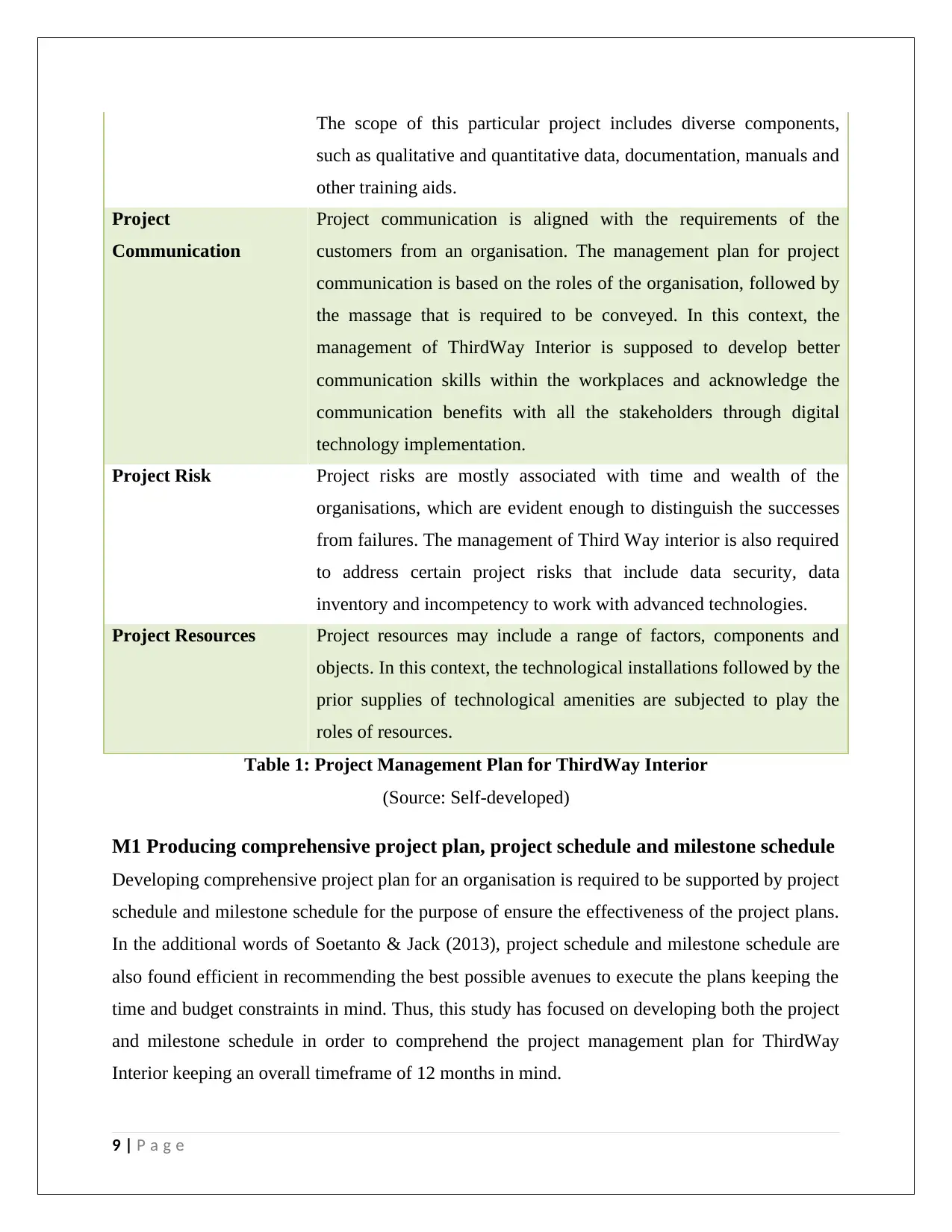
The scope of this particular project includes diverse components,
such as qualitative and quantitative data, documentation, manuals and
other training aids.
Project
Communication
Project communication is aligned with the requirements of the
customers from an organisation. The management plan for project
communication is based on the roles of the organisation, followed by
the massage that is required to be conveyed. In this context, the
management of ThirdWay Interior is supposed to develop better
communication skills within the workplaces and acknowledge the
communication benefits with all the stakeholders through digital
technology implementation.
Project Risk Project risks are mostly associated with time and wealth of the
organisations, which are evident enough to distinguish the successes
from failures. The management of Third Way interior is also required
to address certain project risks that include data security, data
inventory and incompetency to work with advanced technologies.
Project Resources Project resources may include a range of factors, components and
objects. In this context, the technological installations followed by the
prior supplies of technological amenities are subjected to play the
roles of resources.
Table 1: Project Management Plan for ThirdWay Interior
(Source: Self-developed)
M1 Producing comprehensive project plan, project schedule and milestone schedule
Developing comprehensive project plan for an organisation is required to be supported by project
schedule and milestone schedule for the purpose of ensure the effectiveness of the project plans.
In the additional words of Soetanto & Jack (2013), project schedule and milestone schedule are
also found efficient in recommending the best possible avenues to execute the plans keeping the
time and budget constraints in mind. Thus, this study has focused on developing both the project
and milestone schedule in order to comprehend the project management plan for ThirdWay
Interior keeping an overall timeframe of 12 months in mind.
9 | P a g e
such as qualitative and quantitative data, documentation, manuals and
other training aids.
Project
Communication
Project communication is aligned with the requirements of the
customers from an organisation. The management plan for project
communication is based on the roles of the organisation, followed by
the massage that is required to be conveyed. In this context, the
management of ThirdWay Interior is supposed to develop better
communication skills within the workplaces and acknowledge the
communication benefits with all the stakeholders through digital
technology implementation.
Project Risk Project risks are mostly associated with time and wealth of the
organisations, which are evident enough to distinguish the successes
from failures. The management of Third Way interior is also required
to address certain project risks that include data security, data
inventory and incompetency to work with advanced technologies.
Project Resources Project resources may include a range of factors, components and
objects. In this context, the technological installations followed by the
prior supplies of technological amenities are subjected to play the
roles of resources.
Table 1: Project Management Plan for ThirdWay Interior
(Source: Self-developed)
M1 Producing comprehensive project plan, project schedule and milestone schedule
Developing comprehensive project plan for an organisation is required to be supported by project
schedule and milestone schedule for the purpose of ensure the effectiveness of the project plans.
In the additional words of Soetanto & Jack (2013), project schedule and milestone schedule are
also found efficient in recommending the best possible avenues to execute the plans keeping the
time and budget constraints in mind. Thus, this study has focused on developing both the project
and milestone schedule in order to comprehend the project management plan for ThirdWay
Interior keeping an overall timeframe of 12 months in mind.
9 | P a g e
⊘ This is a preview!⊘
Do you want full access?
Subscribe today to unlock all pages.

Trusted by 1+ million students worldwide
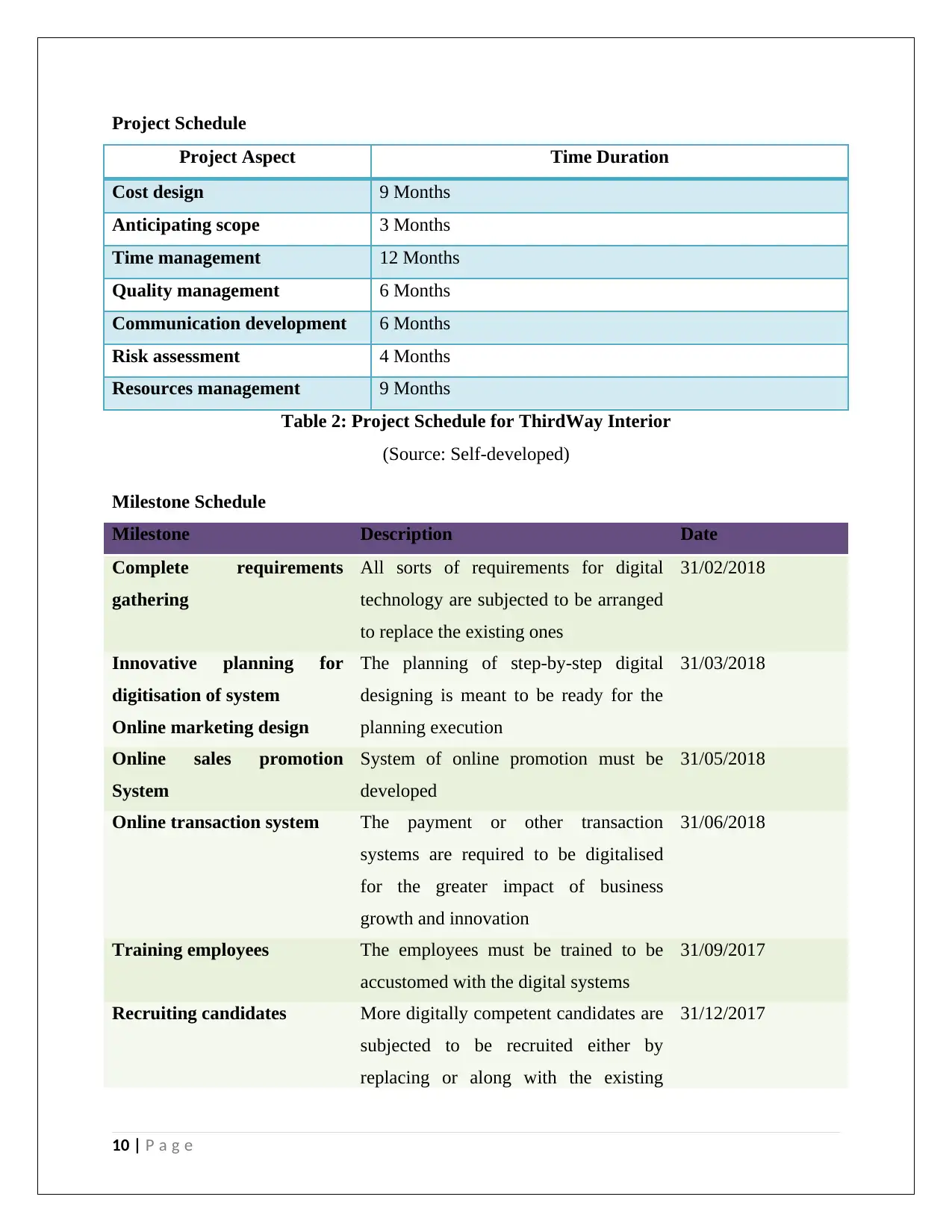
Project Schedule
Project Aspect Time Duration
Cost design 9 Months
Anticipating scope 3 Months
Time management 12 Months
Quality management 6 Months
Communication development 6 Months
Risk assessment 4 Months
Resources management 9 Months
Table 2: Project Schedule for ThirdWay Interior
(Source: Self-developed)
Milestone Schedule
Milestone Description Date
Complete requirements
gathering
All sorts of requirements for digital
technology are subjected to be arranged
to replace the existing ones
31/02/2018
Innovative planning for
digitisation of system
Online marketing design
The planning of step-by-step digital
designing is meant to be ready for the
planning execution
31/03/2018
Online sales promotion
System
System of online promotion must be
developed
31/05/2018
Online transaction system The payment or other transaction
systems are required to be digitalised
for the greater impact of business
growth and innovation
31/06/2018
Training employees The employees must be trained to be
accustomed with the digital systems
31/09/2017
Recruiting candidates More digitally competent candidates are
subjected to be recruited either by
replacing or along with the existing
31/12/2017
10 | P a g e
Project Aspect Time Duration
Cost design 9 Months
Anticipating scope 3 Months
Time management 12 Months
Quality management 6 Months
Communication development 6 Months
Risk assessment 4 Months
Resources management 9 Months
Table 2: Project Schedule for ThirdWay Interior
(Source: Self-developed)
Milestone Schedule
Milestone Description Date
Complete requirements
gathering
All sorts of requirements for digital
technology are subjected to be arranged
to replace the existing ones
31/02/2018
Innovative planning for
digitisation of system
Online marketing design
The planning of step-by-step digital
designing is meant to be ready for the
planning execution
31/03/2018
Online sales promotion
System
System of online promotion must be
developed
31/05/2018
Online transaction system The payment or other transaction
systems are required to be digitalised
for the greater impact of business
growth and innovation
31/06/2018
Training employees The employees must be trained to be
accustomed with the digital systems
31/09/2017
Recruiting candidates More digitally competent candidates are
subjected to be recruited either by
replacing or along with the existing
31/12/2017
10 | P a g e
Paraphrase This Document
Need a fresh take? Get an instant paraphrase of this document with our AI Paraphraser
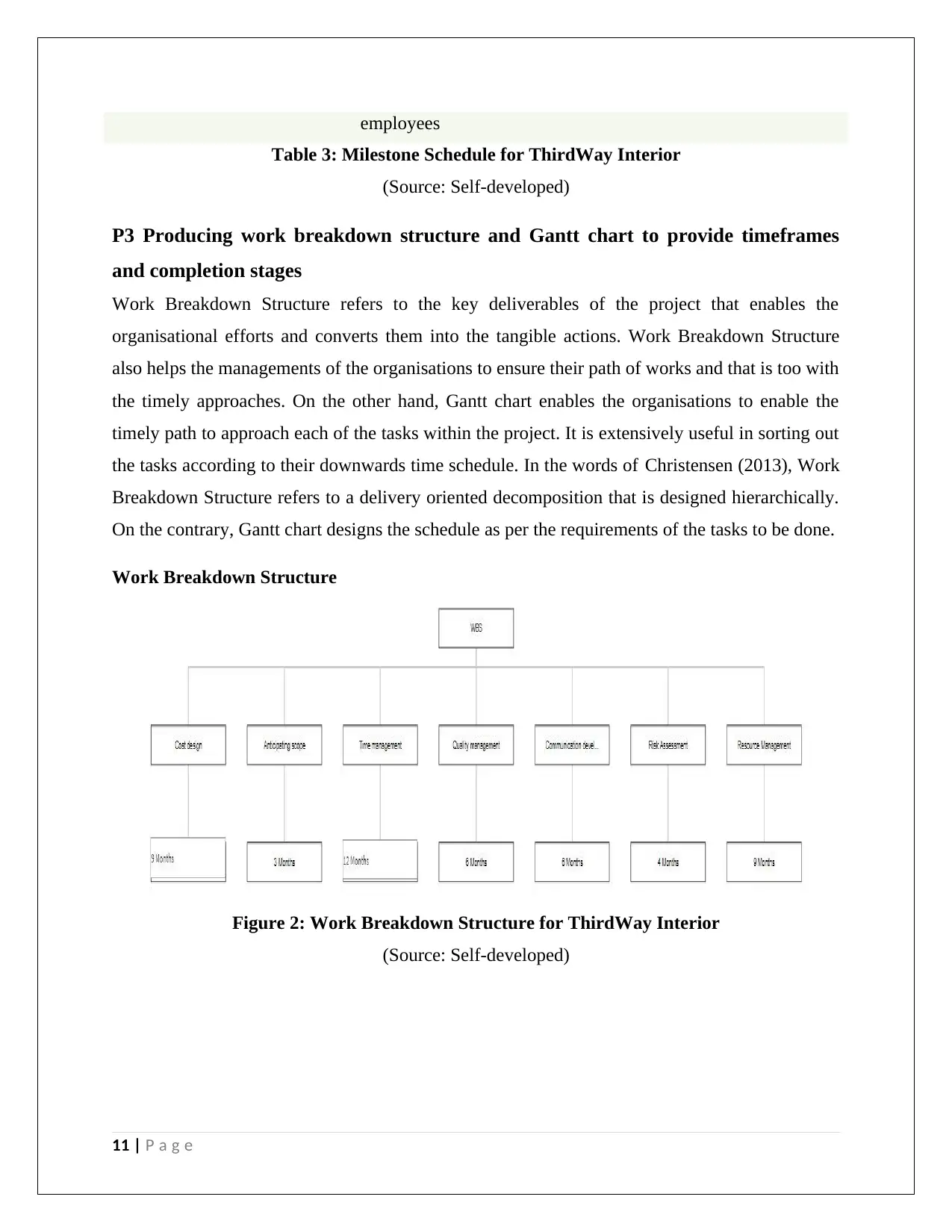
employees
Table 3: Milestone Schedule for ThirdWay Interior
(Source: Self-developed)
P3 Producing work breakdown structure and Gantt chart to provide timeframes
and completion stages
Work Breakdown Structure refers to the key deliverables of the project that enables the
organisational efforts and converts them into the tangible actions. Work Breakdown Structure
also helps the managements of the organisations to ensure their path of works and that is too with
the timely approaches. On the other hand, Gantt chart enables the organisations to enable the
timely path to approach each of the tasks within the project. It is extensively useful in sorting out
the tasks according to their downwards time schedule. In the words of Christensen (2013), Work
Breakdown Structure refers to a delivery oriented decomposition that is designed hierarchically.
On the contrary, Gantt chart designs the schedule as per the requirements of the tasks to be done.
Work Breakdown Structure
Figure 2: Work Breakdown Structure for ThirdWay Interior
(Source: Self-developed)
11 | P a g e
Table 3: Milestone Schedule for ThirdWay Interior
(Source: Self-developed)
P3 Producing work breakdown structure and Gantt chart to provide timeframes
and completion stages
Work Breakdown Structure refers to the key deliverables of the project that enables the
organisational efforts and converts them into the tangible actions. Work Breakdown Structure
also helps the managements of the organisations to ensure their path of works and that is too with
the timely approaches. On the other hand, Gantt chart enables the organisations to enable the
timely path to approach each of the tasks within the project. It is extensively useful in sorting out
the tasks according to their downwards time schedule. In the words of Christensen (2013), Work
Breakdown Structure refers to a delivery oriented decomposition that is designed hierarchically.
On the contrary, Gantt chart designs the schedule as per the requirements of the tasks to be done.
Work Breakdown Structure
Figure 2: Work Breakdown Structure for ThirdWay Interior
(Source: Self-developed)
11 | P a g e
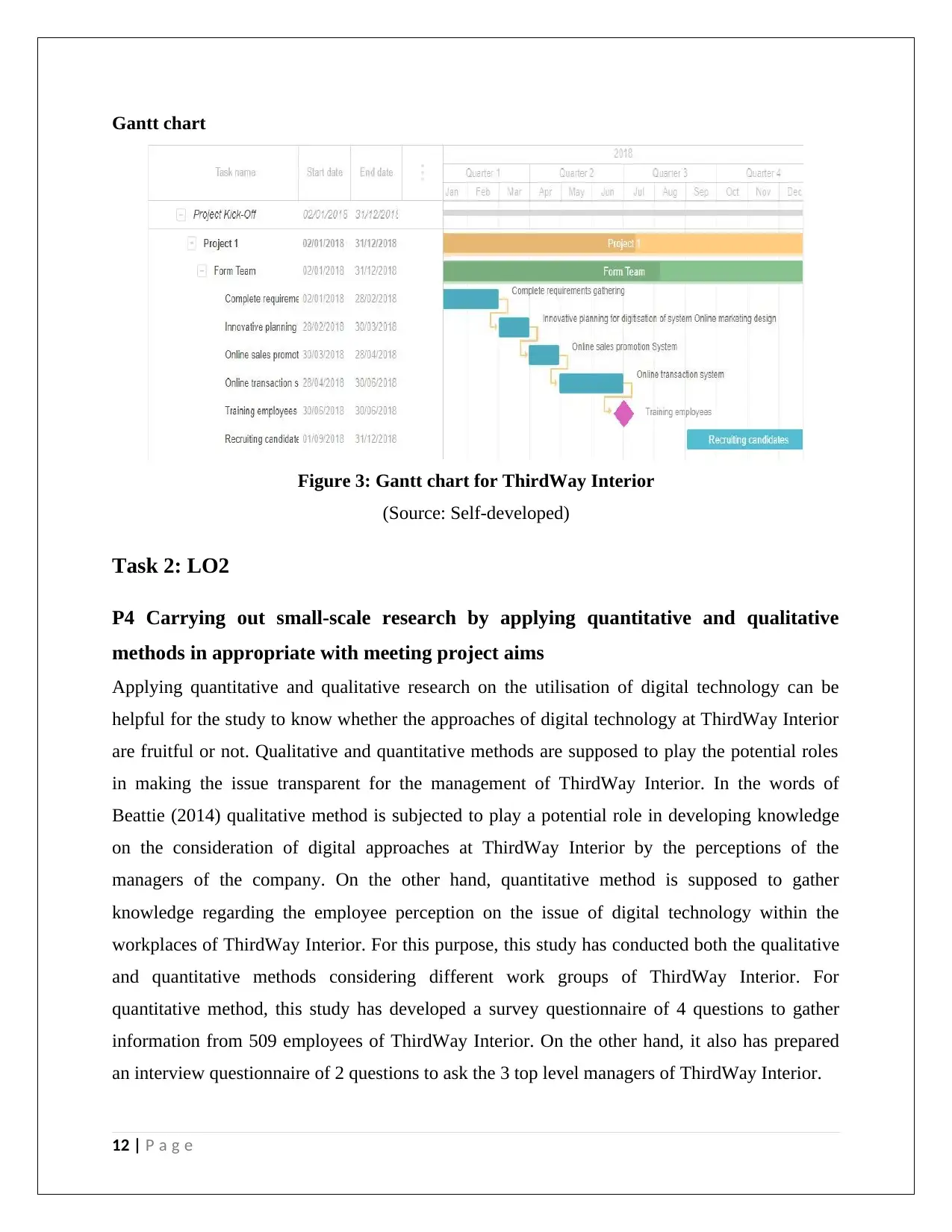
Gantt chart
Figure 3: Gantt chart for ThirdWay Interior
(Source: Self-developed)
Task 2: LO2
P4 Carrying out small-scale research by applying quantitative and qualitative
methods in appropriate with meeting project aims
Applying quantitative and qualitative research on the utilisation of digital technology can be
helpful for the study to know whether the approaches of digital technology at ThirdWay Interior
are fruitful or not. Qualitative and quantitative methods are supposed to play the potential roles
in making the issue transparent for the management of ThirdWay Interior. In the words of
Beattie (2014) qualitative method is subjected to play a potential role in developing knowledge
on the consideration of digital approaches at ThirdWay Interior by the perceptions of the
managers of the company. On the other hand, quantitative method is supposed to gather
knowledge regarding the employee perception on the issue of digital technology within the
workplaces of ThirdWay Interior. For this purpose, this study has conducted both the qualitative
and quantitative methods considering different work groups of ThirdWay Interior. For
quantitative method, this study has developed a survey questionnaire of 4 questions to gather
information from 509 employees of ThirdWay Interior. On the other hand, it also has prepared
an interview questionnaire of 2 questions to ask the 3 top level managers of ThirdWay Interior.
12 | P a g e
Figure 3: Gantt chart for ThirdWay Interior
(Source: Self-developed)
Task 2: LO2
P4 Carrying out small-scale research by applying quantitative and qualitative
methods in appropriate with meeting project aims
Applying quantitative and qualitative research on the utilisation of digital technology can be
helpful for the study to know whether the approaches of digital technology at ThirdWay Interior
are fruitful or not. Qualitative and quantitative methods are supposed to play the potential roles
in making the issue transparent for the management of ThirdWay Interior. In the words of
Beattie (2014) qualitative method is subjected to play a potential role in developing knowledge
on the consideration of digital approaches at ThirdWay Interior by the perceptions of the
managers of the company. On the other hand, quantitative method is supposed to gather
knowledge regarding the employee perception on the issue of digital technology within the
workplaces of ThirdWay Interior. For this purpose, this study has conducted both the qualitative
and quantitative methods considering different work groups of ThirdWay Interior. For
quantitative method, this study has developed a survey questionnaire of 4 questions to gather
information from 509 employees of ThirdWay Interior. On the other hand, it also has prepared
an interview questionnaire of 2 questions to ask the 3 top level managers of ThirdWay Interior.
12 | P a g e
⊘ This is a preview!⊘
Do you want full access?
Subscribe today to unlock all pages.

Trusted by 1+ million students worldwide
1 out of 26
Related Documents
Your All-in-One AI-Powered Toolkit for Academic Success.
+13062052269
info@desklib.com
Available 24*7 on WhatsApp / Email
![[object Object]](/_next/static/media/star-bottom.7253800d.svg)
Unlock your academic potential
Copyright © 2020–2025 A2Z Services. All Rights Reserved. Developed and managed by ZUCOL.




